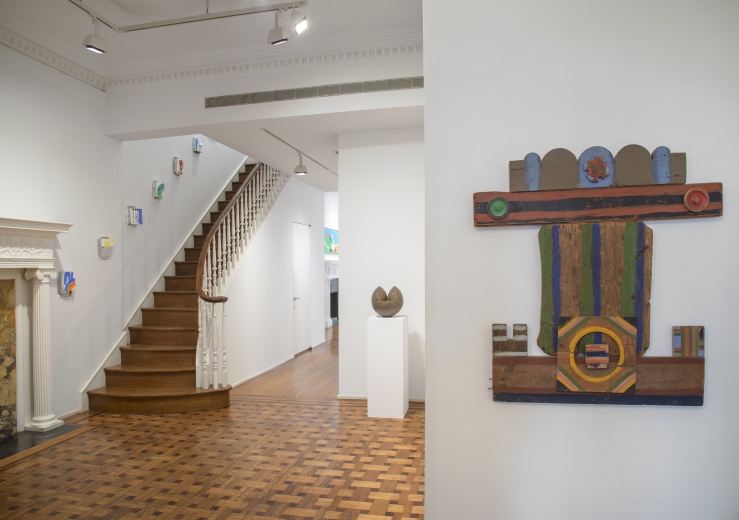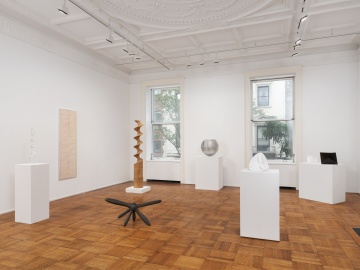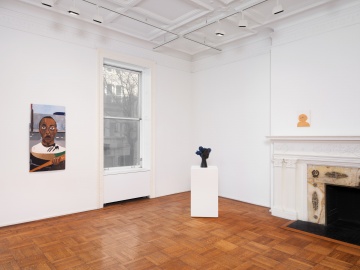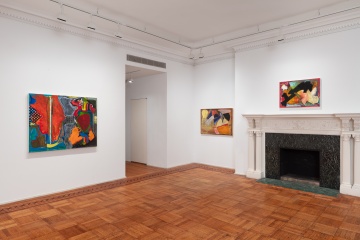Tilton Gallery
8 East 76th Street
New York, NY 10021
212 737 2221
New York, NY 10021
212 737 2221
Since 1983, the Tilton Gallery has been well known for discovering and promoting cutting edge, emerging artists from around the world. For more than three decades, Tilton has exhibited hundreds of contemporary artists, many of whom, like David Hammons, Marlene Dumas, Fred Tomaselli, Huang Yong Ping and Francis Alys, to name but a few, have become prominent figures on the international stage.
Now housed in a historic landmark Upper East side townhouse, the gallery’s current exhibition program continues to support our established gallery artists, and remains committed to discovering and cultivating new talent from around the globe.
The 2,400 square foot exhibition space is located on two floors at 8 East 76th Street, at 5th Avenue, New York. Within New York’s ‘museum mile,’ the gallery is in walking distance from The Metropolitan Museum of Art, The Guggenheim Museum and the Frick Museum, as well as many other Upper East side galleries.
Artists Represented:
Zachary Armstrong
Zachary Armstrong
Egan Frantz
Tomashi Jackson
February James
Antone Konst
John Outterbridge
Rebecca Purdum
Noah Purifoy
Abby Robinson
Berend Strik
Texas Isaiah
Anna Tsouhlarakis
Martha Tuttle
The Estate of Ruth Vollmer
Brenna Youngblood
Gang Zhao
Works Available By:
Derrick Adams
Derrick Adams
Noel Anderson
Wallace Berman
Ed Clark
Noah Davis
Marlene Dumas
Mel Edwards
Nicole Eisenman
Chitra Ganesh
Merik Goma
David Hammons
Yashua Klos
Jarbas Lopes
Senga Nengudi
Henk Peeters
Zhang Peili
Betye Saar
Sudarshan Shetty
Jeff Sonhouse
Richard Tuttle
Timothy Washington

Installation view courtesy Tilton Gallery.
Ruth Vollmer
September 30, 2025 - December 13, 2025
Tilton Gallery is pleased to present an exhibition of the sculpture and drawings of Ruth Vollmer, an influential force in abstract art of the sixties and seventies when she showed with Betty Parsons. Jack Tilton represented her estate since he opened in 1983, and we are honored to present the most comprehensive gallery show of her work since the eighties.
Ruth Vollmer was as much of an individualist and free thinker as her dealer, Betty Parsons. Born in 1903 in Munich, Germany, she came from an intellectual Jewish family, surrounded by discussions about music, literature, science and art. She and her husband, a physician, came to the United States in 1935 where she worked as a designer for many years and became a dedicated artist later in life. She was an influential figure in the circle around Betty Parsons Gallery and was given seven solo shows from 1960 to 1979. It seemed natural as she became part of the New York art world to hold her own version of the European salon, frequent dinners for fellow artists and art world people. Close to Parsons in age, like her, she surrounded herself by artists of a younger generation, many of whom would become called Post-Minimalists or Minimalists: Eva Hesse, Sol LeWitt, Richard Tuttle, Mel Bochner, Robert Smithson and many others.
Vollmer’s work holds its own unique place in art history. With European influences that she brought with her, from the Bauhaus to Surrealism, from Naum Gabo to Alberto Giacometti, her milieu upon arrival in the U.S. exposed her to the New York School and then the newer movements of the sixties and seventies when she began showing with Betty Parsons. While her work shares some of the concerns of her many inspirations, it became something uniquely her own and evades easy assimilation into any single art historical narrative. Both pragmatic and spiritual, her work was informed by her interest in science and mathematics as well art and nature. Both Vollmer’s sculptures and drawings reveal the poetry of line and form.
Her early bronze sculpture explored the eternal, natural form of the sphere. The earliest more roughly hewn shapes were refined and became more defined and minimal over time. Later sculptures were made of cutting-edge newer materials such as acrylic and spun aluminum, making visible her own abstracted mathematical formulas. Her eccentric variations on geometric forms included the spiral, pseudosphere, heptahedron and parabola as well as the sphere. Graphite drawings also drew on mathematical sources as well as nature, but repetitive abstract lines and shapes retain an individuality and expressive quality in their sensitivity of line. Only a few works on paper relate directly to specific sculptures. Both simple and complex, her works have clarity, while retaining a sense of the mysteries of the world.
Vollmer’s work is held in numerous museum collections including those of the Museum of Modern Art, New York to which she donated her personal collection of works by fellow artists; the Whitney Museum of Art, New York; the National Gallery of Art, Washington, D.C.; the Moderna Museet, Stockholm, Sweden and the Kunstmuseum Winterthur, Switzerland, among many others. Solo museum exhibitions have included those at Drew University, New Jersey in 1971; Everson Museum of Art, Syracuse, NY (catalogue) in 1974; the Neuberger Museum of Art, Purchase, NY in 1976; and Sullivant Gallery, Ohio State University in 1976. In 2003, a retrospective and accompanying monograph was organized by the ZKM | Center for Art and Media Karlsruhe, Germany and traveled to Germany, Austria and the U.S. Among group exhibitions, Vollmer was included in Flyktpunkter / Vanishing Points: Mel Bochner, Tom Doyle, Dan Graham, Eva Hesse, Sol LeWitt, Robert Smithson, Ruth Vollmer at the Moderna Museet, Stockholm in 1984.
Intrigue
January 23, 2025 - March 8, 2025
Intrigue: Paweł Althamer, Kai Althoff, Erik Andriesse, Firelei Baez, John Baldessari, Patty Chang, Renee Cox, Noah Davis, Marlene Dumas, Derek Fordjour, Genevieve Gaignard, Vincent Geyskens, Lyle Ashton Harris, Titus Kaphar, Simone Leigh, Nate Lowman, Richard Prince, Malick Sidibé, Henry Taylor, Kara Walker
Tilton Gallery is pleased to present Intrigue, a group exhibition of diverse artists with works from the 1970s to the present. The exhibition will open Thursday, January 23rd from 6:00 to 8:00pm and extend till March 8th.
Art can be straightforward or art can have mystery. The works in this exhibition all hold something back, present an enigma, a sense of intrigue. Many figures turn or glance to the side, others stare straight ahead as if to challenge. None are portraits. Conceptual or surreal, some are reticent, some have an attitude and all intrigue.
Malcolm Mooney
Malcolm Mooney: Artifacts, Rituals, and Trespasses
September 4, 2024 - December 20, 2024
Tilton Gallery is proud to present a solo exhibition of works by visual artist, vocalist, poet, and lyricist Malcolm Mooney. The exhibition will open on Wednesday, September 4th with a reception for the artist from 6:00 to 8:00PM and will be on view through December 20th. This is the artist’s first exhibition with Tilton.
The artist was born in Yonkers in 1944. He received his BFA from the Boston University School of Fine and Applied Arts in 1978 and his MFA from California State University in 1987. Mooney’s storied career has spanned the disciplines of visual art and music for over 50 years. He has performed and exhibited extensively throughout the United States, Canada, and Europe. Exhibition venues include the Aspen Art Museum and White Columns, New York. Most recently, he exhibited in Düsseldorf, Germany in 2023. He has lived in Germany, New York, and Los Angeles and currently lives and works in Calgary, Canada where he teaches at the Alberta University of the Arts.
The exhibition will include seminal early abstract paintings and works on paper from the 1970s to 1980s as well as examples of works from as recent as 2020. Renowned for his avant-garde music and performances, Mooney’s concurrent dedication to making paintings and drawings is less well known. Tilton is excited to bring to light a strong group of works that span this long career and highlight the artist’s ongoing exploration of light, color and structure.
The works on view cover different periods in his art, from bold expressionistic gestures to more formal geometric experiments. Throughout, rhythm and syncopation play an important role, anchoring each work
and echoing Mooney’s emphasis on improvisation and the rhythmic flow so central to his music and poetry. Vibrant color defines Mooney’s palette, calling to mind Kandinsky’s theories about the relationship of color to sound. He has a history of strong ties with other artists, such as Frederick J. Brown, Gregory Edwards, Ulrich Rückriem, and Ed Clark, for whom he was a studio assistant from 2007 to 2010.
Mooney was the original vocalist of the German experimental rock band CAN, whose 1969 debut album, Monster Movie, became one of the most influential recordings in contemporary music. He has performed with many of the great contemporary musicians and he is presently the lead singer in his band, Eleventh Planet.
Abby Robinson
April 23, 2024 - June 28, 2024
Tilton Gallery is pleased to present an exhibition of new paintings and sculptures by Abby Robinson. This is her first solo exhibition and follows her presentation at the Independent New York 2023. The exhibition will open on April 23rd with a reception for the artist from 6:00 to 8:00PM.
Robinson creates new forms of abstraction in an inventive practice that spans painting, sculpture, and installation. Her works explore formal questions of color, scale, and space. She uses both traditional and unexpected materials applied with deliberate and intuitive methods to create new compositions and surfaces. These varied abstractions open up fresh spaces for contemplation, enjoyment, and exploration.
Paint is applied in brushstrokes and washes, elements are collaged on, surfaces are built up and sanded down. Washes of bright and natural color spread across canvas and wood. Lines run throughout, playful and deliberate, drawn with a rainbow crayon or dug into wood with a Dremel. Lines zigzag, squiggle, loop, backtrack, and almost meander; yet they have purpose. Patterns start to appear, often grids, but on the verge of collapse. An order is visible but subverted. A certain shape might appear in a painting then reappear elsewhere as a sculpture. An object might be added and subtracted, leaving a mark and impression.
A varied body of abstract works emerges through this use of disparate materials and methods. Yet the works all share the same attitude and intensity. A near monochrome is alive and at ease next to a panel filled with frenetic lines. Each is invested with the same attention and consideration. Some are minimal, achieved with a seemingly light touch. Thin washes of paint are applied quickly, demanding athleticism and an embrace of chance. Others are clearly layered and worked over. Deeper surfaces are sanded down in specific spots to reveal earlier layers of paint and material. All are created with an economy of moves. Quick, decisive moments are countered with slower ones.
Alongside paintings, patches of painted plaster “Forms” appear. Most hang on the wall, some sit on pedestals or tables, some can do both. Each can stand alone, yet they often come together in intuitive arrangements. Each “Form,” as the artist calls them, is unique. Plaster is poured and molded into similar yet singular shapes with jagged or smooth edges. The plaster is then painted, sometimes carved into, drawn onto, or speckled with stones. The surfaces range from flat and smooth to rough and rocky. Uneven plaster can feel like a familiar expanse of earth or possibly from another planet. Like paintings, they offer space for contemplation. Their direct color and three-dimensionality deepen this experience.
Abby Robinson was born in 1984 in New Orleans, LA and received her Master of Fine Arts from Columbia University School of the Arts in 2022. In 2023, Tilton Gallery exhibited a solo presentation of new works at the Independent Art Fair in New York. Robinson has participated in group exhibitions at half gallery, New York and Golsa Gallery, Oslo, Norway. Her work has been featured in New American Paintings and Architectural Digest. This summer, Robinson will be a Visiting Artist at the American Academy in Rome. She lives and works in New York.
John Outterbridge
February 7, 2024 - April 13, 2024
Tilton Gallery is honored to present an exhibition of works by John Outterbridge. This is the artist’s fourth solo show at the gallery and the first comprehensive exhibition since his death in 2020. There will be an opening reception on Wednesday, February 7th from 6:00 to 8:00PM. The exhibition spans his groundbreaking career and includes examples from the 1960s through the 2010s.
An artist, philosopher, thinker, community activist and mentor to other artists, John Outterbridge was born in 1933 in Greenville, North Carolina. He moved to Los Angeles from Chicago in 1963. In Los Angeles, he soon became a central and outspoken figure in the art community that included Noah Purifoy, David Hammons, Betye Saar, John Riddle and many others. He was co-founder and Artistic Director of the Communicative Arts Academy in Compton, CA from 1969-1975 and Director of the Watts Towers Arts Center in South Central Los Angeles from 1975-1992, succeeding his predecessor Noah Purifoy, and continuing to bring the arts and art education into the African American community.
Outterbridge’s work reflects both his experiences in the segregated South of the 1940s and 1950s and his involvement in the Los Angeles Black Arts Movement during the civil rights era. He grew up in a house and community where the re-purposing of discarded materials and objects was a given. His father moved “junk” for a living, storing the objects he collected in the family backyard till they found a new use. In Los Angeles, Simon Rodia’s Watts Towers, adjacent to the Watts Towers Arts Center, represented a powerful example of how fragmented, found materials could be repurposed into an object of beauty.
Outterbridge from early on assembled materials, found objects, and fragments of fabric into works of art that spoke to the human condition. Abstracted from their original uses, these materials became a language of both poetry and politics, commenting both on the history of African Americans in this country and the specific conditions of Black life. Outterbridge’s work evolved from abstraction to figuration and back to abstraction and in all cases found meaning both in the materials he used and how he used them. More often than not, his work spoke through symbolism and poetic metaphor, with titles adding historical references and word play endowing the work with twists of humor.
Throughout his career, Outterbridge worked in overlapping and at times intertwining series, many of which are represented in this exhibition.
Beginning in the 1960s, Outterbridge created a large group of works he named the Containment Series. These works were made of hammered and assembled sheets of metal, often combined with wood and leather. He gathered fragments of metal throughout LA, often walking by the railroad tracks with other artist friends, such as John Riddle. He worked the metal by hand till Mark di Suvero, who he met when he worked at the Pasadena Art Museum as preparator and educator, lent him his tools for working with metal when he left the city. Although visually abstract, this body of work speaks to the constraints of slavery and the continuing contemporary containment of Black Americans from freedom.
This was closely followed by the Rag Man Series, works made of sewn and painted canvas, stuffed with fabric to create literal and abstract three-dimensional stuffed and painted canvas “bags”, some with disjunctive American flag images painted on the surfaces. Unfortunately, many of these works have disappeared, but three major works remain: Case in Point, Rag Man Series, 1970 in the collection of the Hammer Museum, Los Angeles, Plus-Tax: Shopping Bag Society, Rag Man Series, 1971 in the collection of the National Gallery of Art, Washington D.C., and Jive Ass Bird, Rag Man Series, 1971 in private hands.
Outterbridge’s Ethnic Heritage Series, roughly 1971-1982, is more directly figurative and addresses the question of ancestry. Complex, often abstracted figures reference African sculpture and ethnic effigies. These works extend the early “Rag Man” stuffed canvas shapes, turning them into representations of human figures such as Broken Dance in the collection of the Museum of Modern Art. Many of the figures from the Ethnic Heritage Series are personalized. Outterbridge carved their heads, placing them atop figures and wood structures that are clothed in colorful scraps of fabric. Urban Man, 1981 shows the head of a man peering out of a large almost space-age entrapment.
Other of these figures are individualized by braided hair and bear beaded necklaces, anklets and other charms, such as in Untitled, 1975 in the present exhibition, a sculpture of a female figure with ornate garments and beads carrying a bucket filled with black eyed peas that especially speaks to her African ethnic heritage. Tribal Figure, Ethnic Heritage Series, c. 1978-82 is a male figure that carries his assembled and ethnic garb and painted features regally.
A particularly strong and mysterious example of these figures, also in our exhibition, is the early Captive Image, Ethnic Heritage Series, c. 1971-72, one of a larger sub-series with this title. This figure exhibits two masklike heads attached to an abstracted torso, symbolic of conflicting public and interior personalities, a forced duality that was part of African American life in days of captivity and still in the present day. Another work from this subseries, also called Captive Image, Ethnic Heritage Series, 1978-82 displays the torso and legs of a figure, thrown across a wooden cart, directly referring to the history of captivity.
Another cart in this show, entitled Missing Mule, Ethnic Heritage Series, 1993 speaks to another theme Outterbridge often returns to in both content and title of numerous works. This cart, missing a mule to draw it, calls attention to the artist’s continuous search for the freedom symbolized by the mule and forty acres promised to slaves upon emancipation and not received; Outterbridge reasserts his claim for all African Americans.
The mule, usually missing, literally appears, along with more scraps of torn or discarded materials, in an elaborate, otherwise abstract, Untitled wall sculpture of 2006. The long twig in this work, wrapped in these rags, including bits of the American flag, represents family lineage to the artist, referring again to history, both personal and that of the human race.
Outterbridge’s incorporation of the American flag in his work, almost always partial, but recognizable, is another recurring theme throughout his work, from early examples to his very late work.
In the 1990s, Outterbridge returned to working with metal and wood, all the while continuing his use of discarded bits of fabric, including bits of torn American flags, important in his works from all periods. Window with Footnote, 1991, a metal wall construction with a recessed “window” in which sits a wooden leg, wrapped in fabric strips, as if to heal an injury. From 2009 to 2012, Outterbridge made a large series of smaller wood and metal sculptures that refer back to instruments of containment as well as healing. I Mus Speak, 2012 in this show contains a small, but complete American flag amidst its otherwise abstract assembled parts.
Rag and Bag Idiom IV, 2012 belongs to one of the last series of works Outterbridge made. Harking back to the early Rag Man Series, they are made of canvas, sewn to construct multiple small irregular three-dimensional shapes, stuffed to maintain these shapes. Smaller than most of the earlier Rag Man works, these are painted in bright multi-colored hues. Remnants of other colored fabric or rags are attached and hang loosely. Dynamic and forceful for their size, these works convey Outterbridge’s inner optimism and add a fresh, new dimension to contemporary abstract art.
Finally, we are delighted to present a re-installation of Rag Factory III. Outterbridge’s series of Rag Factory installations was first conceived for an exhibition in 2011 that was part of the Pacific Standard Time Los Angeles initiative, then a second configuration was shown at The Studio Museum in Harlem, and subsequently a third at our gallery and then at the David Zwirner Gallery in London. Not seen in the U.S. since 2012, this exuberant and playful installation takes the artist’s lifelong interest in the use and re-use of colorful fabric that he always called “rags” to create something akin to a May pole that takes up an entire room.
As expressed in a statement Outterbridge wrote for the initial installation at LAX, “I see a rag as an object of many vibrations…you can’t escape the importance of the rag, no matter where you go or what you do…because of the colors, because of their previous lives and their histories, rags are pretty much a statement about our social position in the world and the importance of the cast-off. I like using metal a great deal too, or really any material that has a voice…I feel good about the use of rag as an expressive element, but I don’t see it as different than other aspects of my life…Rags have always been in and around the environments I’ve been a part of. With me, art has the audacity to be anything it needs to be at a given time. Anything. Because the creative process is the beginning of all things, no matter what we’re doing or where we are going.”
Outterbridge has exhibited widely since the late sixties. His work was included in the Pompidou Center’s ground-breaking 2006 exhibition, Los Angeles, 1955-1985: The Birth of an Artistic Capital and in New York at Tilton Gallery in L.A. Object & David Hammons Body Prints, also 2006. His work was represented in six of the Pacific Standard Time 2011-12 exhibitions in Los Angeles, including in Now Dig This! Art and Black Los Angeles 1960-1980. More recently, it was included in the traveling exhibition organized by the Tate Modern, Soul of a Nation: Art in the Age of Black Power; in Outliers and American Vanguard Art that originated at the National Gallery, Washington, D.C.; and in West by Midwest: Geographies of Art and Kinship at the Museum of Contemporary Art, Chicago, among a multitude of other important museum group shows. Outterbridge also participated in the 2015 Venice Biennale. He had a solo exhibition, John Outterbridge: Rag Man, at Art + Practice, organized by the Hammer Museum in 2015 that traveled to the Aspen Art Museum. His work is in the collections of The Museum of Modern Art, New York, the Whitney Museum of American Art, the Los Angeles County Museum of Art, the San Francisco Museum of Art and the Museum of Fine Arts, Houston, among many others.

 Back to all Member Galleries
Back to all Member Galleries




